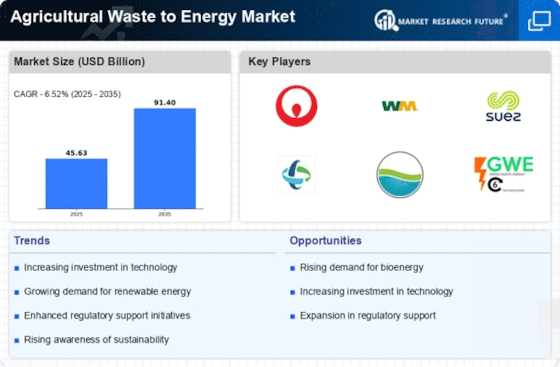Rising Energy Demand
The Agricultural Waste to Energy Market is experiencing a surge in energy demand, driven by the increasing global population and urbanization. As more people migrate to urban areas, the need for sustainable energy sources becomes paramount. This trend is likely to continue, with projections indicating that energy consumption could rise by 30% by 2040. Agricultural waste, which is often underutilized, presents a viable solution to meet this demand. By converting agricultural residues into energy, the industry not only addresses energy shortages but also contributes to reducing greenhouse gas emissions. This dual benefit enhances the attractiveness of the Agricultural Waste to Energy Market, as stakeholders seek innovative ways to fulfill energy needs sustainably.
Technological Innovations
Technological advancements are transforming the Agricultural Waste to Energy Market, making energy conversion processes more efficient and cost-effective. Innovations in anaerobic digestion, gasification, and pyrolysis are enhancing the ability to convert agricultural residues into usable energy forms. For example, recent developments in enzyme technology have improved the breakdown of complex organic materials, increasing energy yields. The market is projected to grow as these technologies become more accessible and affordable, potentially leading to a 20% increase in energy output from agricultural waste by 2030. This technological evolution not only boosts the efficiency of energy production but also attracts new players to the Agricultural Waste to Energy Market, fostering competition and further advancements.
Government Incentives and Policies
Government incentives and supportive policies play a crucial role in the Agricultural Waste to Energy Market. Many countries are implementing regulations that promote renewable energy sources, including biomass derived from agricultural waste. For instance, feed-in tariffs and tax credits are being offered to encourage investment in waste-to-energy projects. These initiatives are expected to stimulate market growth, as they lower the financial barriers for producers and investors. Furthermore, the commitment to achieving renewable energy targets is likely to drive the adoption of agricultural waste conversion technologies. As a result, the Agricultural Waste to Energy Market stands to benefit from a favorable regulatory environment that encourages innovation and investment.
Environmental Concerns and Sustainability
The growing awareness of environmental issues is significantly influencing the Agricultural Waste to Energy Market. As climate change and pollution become pressing global challenges, there is an increasing push for sustainable practices in energy production. Agricultural waste, often viewed as a liability, can be transformed into a valuable resource, thereby reducing landfill waste and lowering carbon footprints. The industry is likely to see heightened interest from both consumers and businesses seeking to align with sustainability goals. Reports suggest that the market could expand by 15% annually as more stakeholders recognize the environmental benefits of converting agricultural waste into energy. This shift towards sustainability is expected to drive innovation and investment in the Agricultural Waste to Energy Market.
Rising Costs of Traditional Energy Sources
The escalating costs of traditional energy sources are prompting a shift towards alternative energy solutions, including those offered by the Agricultural Waste to Energy Market. As fossil fuel prices fluctuate and environmental regulations tighten, agricultural waste presents a cost-effective and renewable energy option. The volatility in energy markets has led to increased interest in biomass energy, which can provide a stable and predictable energy supply. Analysts predict that the Agricultural Waste to Energy Market could see a growth rate of 10% annually as businesses and governments seek to mitigate energy costs. This economic incentive, combined with the environmental benefits, positions agricultural waste as a key player in the future energy landscape.


















Leave a Comment